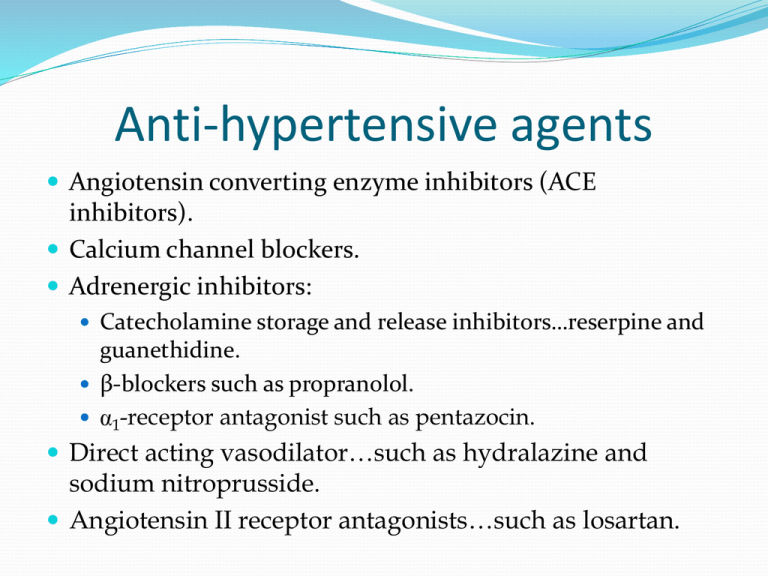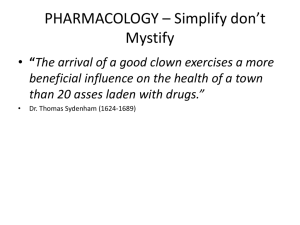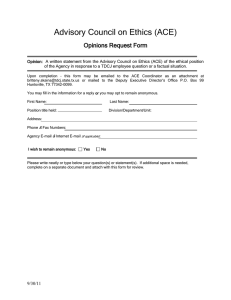Anti-hypertensive agents
advertisement

Anti-hypertensive agents Angiotensin converting enzyme inhibitors (ACE inhibitors). Calcium channel blockers. Adrenergic inhibitors: Catecholamine storage and release inhibitors…reserpine and guanethidine. β-blockers such as propranolol. 1-receptor antagonist such as pentazocin. Direct acting vasodilator…such as hydralazine and sodium nitroprusside. Angiotensin II receptor antagonists…such as losartan. ACE inhibitors A polypeptide ACE inhibitors An other action of ACE is through the metabolism of bradykinin into inactive products: Both mechanism will decrease blood pressure ACE inhibitors ACE is a protease enzyme; it can break the peptide bond: ACE inhibitors Zinc plays an important role in the hydrolysis mechanism: Activate the carbonyl group…makes the carbonyl carbon more electropositive…highly reactive. It also stabilizes the carboxylate anion that formed after the hydrolysis. ACE active site has a high affinity for α-methylsuccinyl proline ACE active site has a high affinity for α-methylsuccinyl proline: Two hydrophobic pocket. A positively charged region. Positively charged Zinc that will bind with the carboxylate anion. ACE inhibitors The prototype of ACE inhibitor is captopril: The main SAR for ACE inhibitors: A zinc coordinating group (carboxylate anion or any other negatively charged species). A carboxylate group to form ionic interaction with the arginin in the active site. A 6-7 atom distance between the carboxylate and the zinc coordinating group. Hydrophobic groups to interact with the two hydrophobic pockets. ACE inhibitors ACE inhibitor prodrugs: They do not have the Zinc coordinating group unless they are metabolized. They are either carboxylate esters, thioester or phosphate esters…upon hydrolysis they will give the anionic carboxylate group. Many examples are available such as enalapril, ramipril, fosenopril, bennazopril, and perindopril ACE inhibitor prodrugs Lisinopril The third ACE inhibitor introduced in the market (1990). It differs from other ACE inhibitors in that: It is more hydrophilic: slow absorption. High volume of distribution. Long half life due to high tissue deposition. It is mainly excreted unchanged in urine…is not metabolized. Temocapril Is a direct acting ACE inhibitor since it has the free carboxylate anion that will coordinate with the zinc cation. Has the lipophilic thiophene ring that will be pointed toward one of the hydrophobic pocket in the active site. ACE inhibitors common S/E Vasodilator edema Persistent dry cough Headache Dizziness Fatigue Nausea Renal impairment Might increase inflammation-related pain (Due to accumulation of pradykinin) Calcium channel blockers (CCB) Calcium plays a major role in the regulation of many cellular processes, mainly in muscle contraction. The entry of extracellular Ca++ into the smooth muscle cytosol and their release from the intracellular storage sites is very important for the initiation of muscle contraction…..vasoconstriction…high blood pressure. Calcium channel blockers will interfere with the entrance of calcium in to the cytosol…vasodilatation…reduce blood pressure. Calcium channel blockers The majority of calcium channel blockers are 1,4- dihydropyridine derivatives. They act mainly on the L-type calcium channel (L for long lasting effect) After binding they cause conformational changes that affect Ca++ movement . Calcium channel blockers Calcium channel blockers No clear SAR for these agents. The difference in their structure will mainly affect the pharmacokinetic profile not the activity or the binding to the calcium channel. Calcium channel blockers The general metabolism for CCB: Direct acting vasodilators Hydralazine: Reduces arteriole peripheral resistance. Interferes with calcium transport and activate guanylate cyclase…increases level of cGMP…vasodilatation. Direct acting vasodilators Hydralazine general metabolism: Novel anti-hypertensive agents Novel mechanism of action is targeting angiotensin II receptors…as blockers; they will prevent the binding of angiotensin II to its receptor…no vasoconstriction. They are competitive inhibitor for the enzyme. The prototype is losartan Losartan metabolism It is metabolized into an active metabolite; the carboxylic acid metabolite: Valsartan (Diovan) Valsartan is a new anti-hypertensive agent with the same mechanism as losartan. The difference in structure between losartan and valsartan is: Valsartan is more polar…has high volume of distribution. Valsartan is a valine containing drug… it will be in zwitterionic form…this reduces its oral absorption. Candesartan (Blopress® , Atacand®) Recent studies revealed that candesartan can reduce the risk of developing hypertension by two third. Used for treating hypertension mainly in combination with thiazide diuretics. Given orally as cilexetil ester prodrug: Telmisartan (Micardis®) Has the longest duration of action (t1/2= 24 hr) and the largest volume of distribution among all angiotensin II receptor blockers: More lipophilic than other derivatives…more fat soluble and high protein binding (>99.5%).






